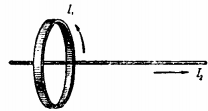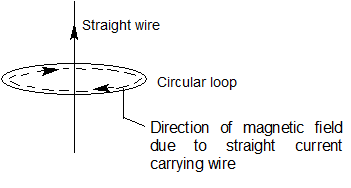
A straight wire carrying a current ${I_2}$ runs along the axis of a circular current ${I_1}$ (Fig.). What is the force of interaction between the currents?

Answer
220.2k+ views
Hint:When a straight wire carrying a current runs along the axis of a circular current, the magnetic field due to the straight wire is in the plane that of the current flow in the circular loop. Also the magnetic field lines of the circular loop carrying current on the axis of the loop are along the axis of the circular loop itself. Thus, the current in the loop and magnetic field will be parallel to each other.
Complete answer:
According to the right hand thumb rule, if a current carrying conductor is imagined to be held in our right hand such that the thumb points directly along the direction of current, then the direction of wrapped fingers will give the direction of magnetic field lines.
As per given question, a straight current carrying conductor is kept along the axis of a circular loop, then according to the right hand thumb rule the direction of the magnetic field is found by the right hand thumb rule and it will be in a plane in a circular loop around a wire.
Now magnetic force on a current-carrying conductor placed in a field is given by
$F=BiL\sin \theta $
Where, $B$ denotes the magnetic field in which the conductor is placed, $i$ is the current, $L$ is the length of the conductor and $\theta $ represents the angle between the direction of magnetic field and the direction of the current.

As we see in the above figure the direction of the magnetic field due to straight wire is in the plane that of the current flow in the circular loop. Therefore magnetic field lines of the circular loop carry current on the axis of the circular loop itself. Thus the angle $\theta$ between the direction of magnetic field $B$ and direction of the current $i$ is zero since $B$ and $i$ are parallel to each other.
Therefore the force $F$ exerted by the magnetic field $B$ is
$F={{I}_{2}}L\times B={{I}_{2}}LB\sin \theta $ (Here for straight current carrying conductor, $i={{I}_{2}}$)
$F={{I}_{2}}L\times B\sin ({{0}^{o}})=0$
$\therefore F=0$
Therefore the interaction between force f interaction between current is zero.
Note: A circular current carrying coil experiences a force perpendicular to the plane of the coil and to the direction of the current. This force is due to the magnetic field created by the current. When current flows through a straight conductor, it produces a force on the conductor that is perpendicular to the direction of the current.
Complete answer:
According to the right hand thumb rule, if a current carrying conductor is imagined to be held in our right hand such that the thumb points directly along the direction of current, then the direction of wrapped fingers will give the direction of magnetic field lines.
As per given question, a straight current carrying conductor is kept along the axis of a circular loop, then according to the right hand thumb rule the direction of the magnetic field is found by the right hand thumb rule and it will be in a plane in a circular loop around a wire.
Now magnetic force on a current-carrying conductor placed in a field is given by
$F=BiL\sin \theta $
Where, $B$ denotes the magnetic field in which the conductor is placed, $i$ is the current, $L$ is the length of the conductor and $\theta $ represents the angle between the direction of magnetic field and the direction of the current.

As we see in the above figure the direction of the magnetic field due to straight wire is in the plane that of the current flow in the circular loop. Therefore magnetic field lines of the circular loop carry current on the axis of the circular loop itself. Thus the angle $\theta$ between the direction of magnetic field $B$ and direction of the current $i$ is zero since $B$ and $i$ are parallel to each other.
Therefore the force $F$ exerted by the magnetic field $B$ is
$F={{I}_{2}}L\times B={{I}_{2}}LB\sin \theta $ (Here for straight current carrying conductor, $i={{I}_{2}}$)
$F={{I}_{2}}L\times B\sin ({{0}^{o}})=0$
$\therefore F=0$
Therefore the interaction between force f interaction between current is zero.
Note: A circular current carrying coil experiences a force perpendicular to the plane of the coil and to the direction of the current. This force is due to the magnetic field created by the current. When current flows through a straight conductor, it produces a force on the conductor that is perpendicular to the direction of the current.
Recently Updated Pages
Mass vs Weight: Key Differences Explained for Students

Young’s Double Slit Experiment Derivation Explained

Electricity and Magnetism Explained: Key Concepts & Applications

JEE Energetics Important Concepts and Tips for Exam Preparation

JEE Isolation, Preparation and Properties of Non-metals Important Concepts and Tips for Exam Preparation

JEE Main 2021 July 25 Shift 1 Question Paper with Answer Key

Trending doubts
JEE Main 2026: Application Form Open, Exam Dates, Syllabus, Eligibility & Question Papers

Understanding Uniform Acceleration in Physics

Derivation of Equation of Trajectory Explained for Students

Hybridisation in Chemistry – Concept, Types & Applications

Understanding the Angle of Deviation in a Prism

How to Convert a Galvanometer into an Ammeter or Voltmeter

Other Pages
JEE Advanced Marks vs Ranks 2025: Understanding Category-wise Qualifying Marks and Previous Year Cut-offs

Dual Nature of Radiation and Matter Class 12 Physics Chapter 11 CBSE Notes - 2025-26

JEE Main Marking Scheme 2026- Paper-Wise Marks Distribution and Negative Marking Details

Degree of Dissociation: Meaning, Formula, Calculation & Uses

Ideal and Non-Ideal Solutions Explained for Class 12 Chemistry

Understanding the Electric Field of a Uniformly Charged Ring




